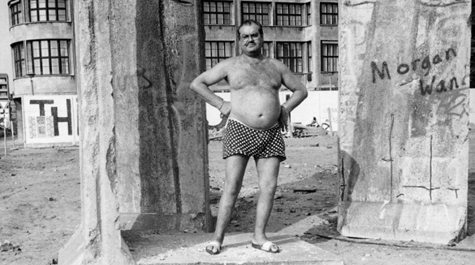Flitner's "No Man's Land" on display at Muscarelle
The Muscarelle Museum of Art presents "After the Fall of the Berlin Wall: Report from No Man’s Land," an exhibition featuring 46 photographs by award winning German photographer, Bettina Flitner, on display February 5 – April 3.
For many months after the fall of the Wall, Flitner explored the former death strip of Berlin, an area that became no man’s land. She met people from the East and West and asked them, “What do you feel now?” "No Man’s Land" is a photographic essay of Berliners’ answers to this question.
Built in an attempt to stop East Berliners from migrating to West Berlin, the Berlin Wall became the symbol of Cold War politics and the ideological divide between capitalism and communism. After World War II, the Allied Powers divided Germany and Berlin into four sections. In the American, British, and French sections democracy and capitalism were promoted and thrived. In the Soviet Union section, communism and dictatorial rule were implemented. It was not long until Soviet and East Berlin officals feared the influence of capitalism and democracy. Accordingly, in the middle of the night in 1961 East Berlin officials erected a wall to stop movement between East and West Berlin. The eastern side of the wall quickly became militarized with watch towers, anti-vehicle trenches, and additional barriers. This area became known as the ”death strip”.
While East Berlin was crumbling politically and economically, West Berlin flourished. The most poignant display of the different cultures in East and West Berlin was the graffitied West Berlin side of the wall symbolizing free expression and speech, and the untouched, white East Berlin side of the wall symbolizing oppression and anti-democratic principles.
The fall of the Berlin Wall began in 1989 when the East German government proclaimed citizens could travel to West Germany. Shortly thereafter, East and West German citizens began flooding across the border to the opposite side. Eventually, Germans and tourists chipped away large parts of the wall as an act of freedom and to keep as souvenirs.
Aaron De Groft, director of the Muscarelle Museum of Art, commented on the exhibition, “Never before has an ideological divide been more visually evident than the erection of the Berlin Wall in 1961. Many enthusiastically remember the fall of the Wall, but few remember how difficult it was for some Germans to adjust to a life without borders. Flitner’s photographs provide insight into the challenges of integrating generations of a divided people.”
The Muscarelle Museum of Art is located on Jamestown Road on the campus of The College of William & Mary in Williamsburg, Virginia. The Museum is open from 10 a.m. until 5 p.m. Tuesday through Friday and 12 p.m. until 4 p.m. on Saturday and Sunday. The Museum is closed on Mondays. Docent tours are available at 1 p.m. on Saturday, Sundays, and other times as announced. Admission to the Museum is $5 and during special exhibitions, there is an admission fee of $10. Admission is free for Museum members, The College of William & Mary faculty, staff, and students, and children under twelve. For more information about this exhibit or the Museum in general, please call 757-221-2700 or visit www.wm.edu/muscarelle.


















